Like many people I try and eat seasonally. Of course I miss summer fruits at this grey time of year, but I find the sight of swollen strawberries coupled with those limp little raspberries really perverse. As in other areas of life, being overly available is not always a good thing. So, it's with real excitement that we usher in the short and definitely not sweet Seville orange season.
Seville oranges are only available from mid January until February and no number of Tesco polytunnels will change this.* These bitter little oranges are the foundation of one of my favourite foods: Marmalade. As I've already confessed, I have a bit of a thing for toasted cheap white bread. I know it's got the nutritional value of cotton wool, but hey-ho, at least I'm honest. I spent many a happy afternoon at university eating Sunblest bread coated in butter and marmalade. Yum.
My first memory of marmalade is my mum's homemade chunky Dundee version. Mum doesn't have a sweet tooth and so this dark treacley spread didn't really appeal to my young palate. In fact, it was only once I was introduced to the delights of the light, sugary Robinson's version that I realised how much I liked it. Sorry mum.
On Sunday I attempted my first homemade Seville orange marmalade using the same book that my Mum took her Dundee recipe from, reassuringly spotted with past successes.
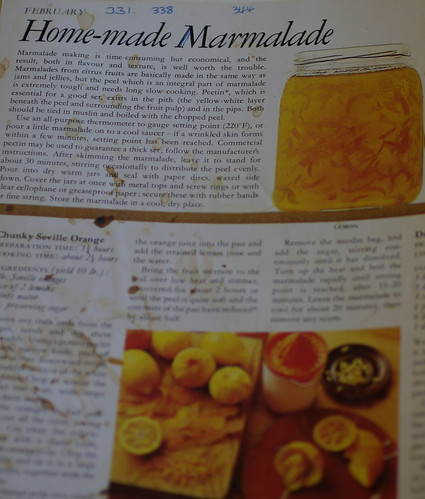 The process of peeling and chopping the fruit is very therapeutic. There is also something so appealing about filling freshly cleaned jam jars with the amber mixture, knowing that even if the worst happens you will always have a store of something you have made yourself.
The process of peeling and chopping the fruit is very therapeutic. There is also something so appealing about filling freshly cleaned jam jars with the amber mixture, knowing that even if the worst happens you will always have a store of something you have made yourself. Unfortunately I was denied the pleasure of merrily labelling my treasure and decorating the lids with little circles of fabric. Yes, I went wrong. Despite buying a new sugar thermometer for the marmalade-making I refused to trust it. Call me a Luddite, call me stupid, but when the thermometer told me that setting point had been reached after only five minutes, I decided that it couldn't be possible. So, a little later and a few degrees higher, I ended up with marmalade toffee rather than the unctuous jelly for my toast. Oh dear.
I promise that before the marma-rock solidified the flavour was perfect. So, please do try this recipe but don't think that you are above your thermometer!
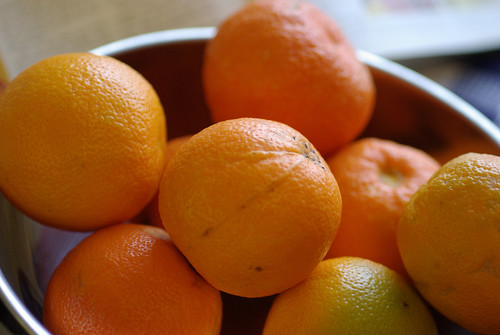
Classic Seville Marmalade
Yields 10lb - you can scale the recipe down but remember that cooking times may need to be reduced slightly to compensate.
3lb Seville oranges
Juice of 2 lemons
6 pints of water
6lb preserving sugar
- Remove any stalk ends from the oranges, give them a good scrub and dry thoroughly.
- Using a potato peeler or a sharp knife peel the rind from the oranges in thin downward strips. You just want to take the coloured rind and leave the white pith on the orange.
- Cut the rind into thin strips using scissors. I prefer thin strips but you can leave them chunkier if you prefer. Set this peel aside.
- Cut the oranges in half and and squeeze all the juice. Be sure to save the pips as these will be used later.
- Once you have extracted all the juice and the pulp from the oranges you can slice the white pith from the inside of the orange skins. The pith is the white material that you normally spend ages fastidiously picking off segments when you eat them. I found that the easiest way of doing this is to turn the empty skins inside out and use scissors to cut it out.
- Chop the pith roughly and gather it together with the pips. Place together in a square of muslin and tie tightly. Unfortunately I didn't have any muslin so I did some Blue Peter style improvisation and used the toe of some clean tights!
- In a large pan put the orange juice, pulp, shredded peel and your little bag of pith. Add the lemon juice and the water.
- Bring the fruit mixture to the boil over a low heat and simmer, uncovered, for about 2 hours or until the peel is soft and the mixture has reduced by about half. Please note that this will take less time if you have reduced the recipe.
- Remove the bag of pith and add your sugar. Stir constantly until the sugar has dissolved. Turn up the heat and boil the mixture rapidly until setting point has been reached. Setting point is 220 degrees Fahrenheit using a sugar thermometer. Note to self: remember this.**
- Leave the marmalade to cool for about 10 minutes and then remove any scum from the surface.
- Pour your delicious citrus mixture into your sterilised jars and enjoy. Cheap white bread is optional.
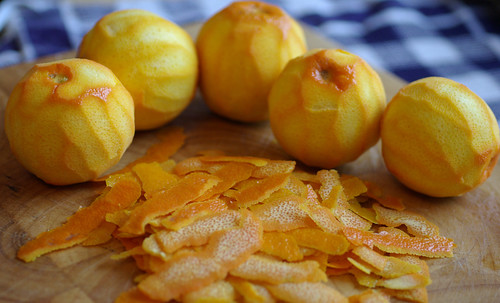

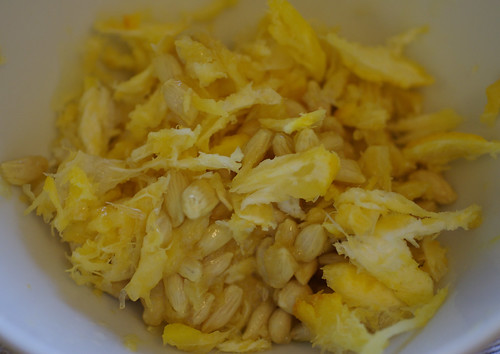
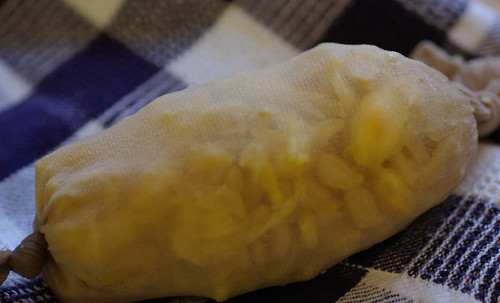
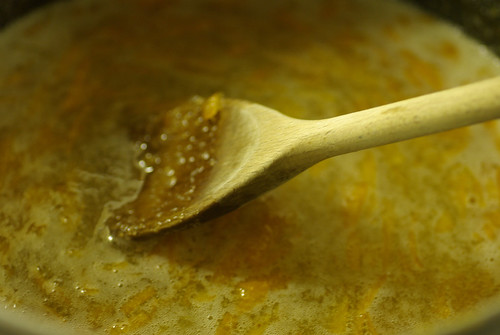

* If, however, you want to buy Seville oranges now but don't have time to make marmalade you can freeze them whole.
** If you don't have a thermometer you can also check whether setting point has been reached by chilling a saucer in the fridge and then pour a little marmalade on to it. If a wrinkled skin forms within a few minutes then it is good to go.


No comments:
Post a Comment